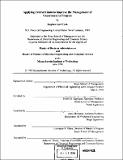Applying Critical Chain to improve the management of uncertainty in projects
Author(s)
Cook, Stephen Carl, 1966-
DownloadFull printable version (8.136Mb)
Advisor
Steven D. Eppinger and Anna Thornton.
Terms of use
Metadata
Show full item recordAbstract
In an ever intensifying global competitive market, the management of projects, particularly product development efforts, increasingly is one of the few areas which can produce a sustained competitive advantage. Firms that can bring products to market faster can extract higher initial margins, can be more responsive to their customers, and will have products with longer sales lives. Critical Chain is a new methodology that applies Eli Goldratt's Theory of Constraints to project management in order complete projects faster and with greater predictability while simultaneously making more efficient use of resources. The Critical Chain method accomplishes this by building project networks with average task durations, aggregating buffer at the end of projects where it can absorb unplanned iterations and other delays, and de-conflicting resources, both within and across projects. This new project management methodology was researched by spending seven months on site with ITT Night Vision and applying the method to two product development projects. In addition, benchmarking studies of previous product development efforts at the same site and of another lead user of the tool were conducted to provide both qualitative and quantitative comparison data. Critical Chain appears to minimize schedule risk while simultaneously minimizing project duration, and has the potential to improve both communication and employee morale.
Description
Thesis (M.B.A.)--Massachusetts Institute of Technology, Sloan School of Management; and, (S.M.)--Massachusetts Institute of Technology, Dept. of Electrical Engineering and Computer Science, 1998. Includes bibliographical references (leaves 76-77).
Date issued
1998Department
Massachusetts Institute of Technology. Department of Electrical Engineering and Computer Science; Sloan School of ManagementPublisher
Massachusetts Institute of Technology
Keywords
Sloan School of Management, Electrical Engineering and Computer Science